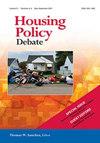Cores and Peripheries: Spatial Analysis of Housing Choice Voucher Distribution in the San Francisco Bay Area Region, 2000–2010
IF 2.9
3区 经济学
Q2 DEVELOPMENT STUDIES
引用次数: 7
Abstract
Abstract This study uses spatial regressions and spatial statistics to examine the changes in the distribution of Housing Choice Voucher (HCV) households within an expanded San Francisco Bay Area region. From 2000 to 2010, the density of HCV households grew disproportionately across the region, and areas of significant increase emerged in both the region’s urban cores and its rural periphery. Furthermore, the destination communities shared a set of common characteristics. In 2010 HCV households were more likely to locate in areas with lower housing prices, lower percentages of educated people, higher rates of poverty, and higher percentages of African American households when compared with the region as a whole. These findings suggest that voucher holders locate where housing is affordable. We conclude that in regions with tight housing markets, supply matters. This study also introduces housing researchers and policy makers to a methodological approach that addresses what is known in geostatistics as a change of support problem.核心与外围:2000-2010年旧金山湾区住房选择券分布的空间分析
摘要本研究采用空间回归和空间统计方法,考察了旧金山湾区扩展后住房选择券(HCV)家庭分布的变化。从2000年到2010年,该地区的HCV家庭密度不成比例地增长,显著增长的地区出现在该地区的城市核心和农村边缘。此外,目的地社区还具有一系列共同特征。2010年,与整个地区相比,HCV家庭更有可能位于房价较低、受教育人口比例较低、贫困率较高、非裔美国人家庭比例较高的地区。这些发现表明,持有代金券的人会选择住房负担得起的地方。我们的结论是,在住房市场紧张的地区,供应很重要。本研究还向住房研究人员和政策制定者介绍了一种方法方法,该方法解决了地质统计学中所谓的支持变化问题。
本文章由计算机程序翻译,如有差异,请以英文原文为准。
求助全文
约1分钟内获得全文
求助全文
来源期刊

Housing Policy Debate
Multiple-
CiteScore
5.40
自引率
17.20%
发文量
68
期刊介绍:
Housing Policy Debate provides a venue for original research on U.S. housing policy. Subjects include affordable housing policy, fair housing policy, land use regulations influencing housing affordability, metropolitan development trends, and linkages among housing policy and energy, environmental, and transportation policy. Housing Policy Debate is published quarterly. Most issues feature a Forum section and an Articles section. The Forum, which highlights a current debate, features a central article and responding comments that represent a range of perspectives. All articles in the Forum and Articles sections undergo a double-blind peer review process.
 求助内容:
求助内容: 应助结果提醒方式:
应助结果提醒方式:


